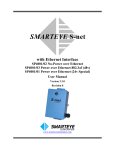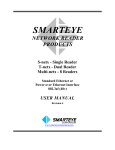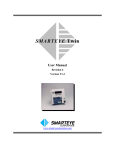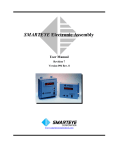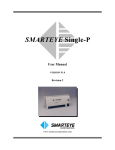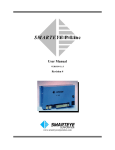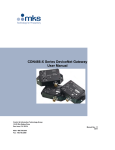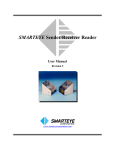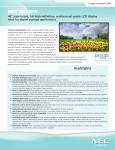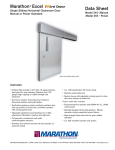Download SP4000-01 S-net DeviceNet User Manual
Transcript
SMARTEYE S-net with DeviceNet Interface SP4000/01 User Manual Version 1.0.5 Revision 3 www.smarteyecorporation.com related documents: SMARTEYE Sender/Receiver Reader User Manual The material in this manual is for informational purposes and is subject to change without notice. Smarteye Corporation assumes no responsibility for any errors which may appear in this manual. © Smarteye Corporation SMARTEYE is a registered trademark of Smarteye Corporation. BELDEN is a registered trademark of Belden CDT Inc. DeviceNet is a trademark of the Open DeviceNet Vendors Association. Allen-Bradley and PLC-5 are trademarks of Rockwell Automation. RSNetWorx, RSLinx, and RSLogix5 are trademarks of Rockwell Software Inc., a Rockwell Automation company. Printed in U.S.A. SMARTEYE contact information: SMARTEYE Corporation 2637 Bond Street Rochester Hills, MI 48309 Phone: (248) 853-4495 Fax: (248) 853-8539 www.smarteyecorporation.com Email: [email protected] SMARTEYE S-net SP4000/01 User Manual Page i TABLE OF CONTENTS 1.0 Introduction........................................................................................................... 1 2.0 S-net Features........................................................................................................ 1 3.0 S-net Installation ................................................................................................... 1 4.0 Power Wiring and Power Consumption ............................................................. 1 5.0 Communications Wiring ...................................................................................... 2 5.1 Control Port Wiring ............................................................................................................2 5.2 Auxiliary Port Wiring .........................................................................................................2 6.0 Reader Wiring and Mounting ............................................................................. 2 6.1 S-net Reader Wiring ...........................................................................................................2 6.2 Local Reader Mounting ......................................................................................................2 6.3 Remote Reader Mounting ...................................................................................................3 7.0 S-net CPU Configuration ..................................................................................... 3 7.1 Switch and Jumper Location Diagram................................................................................4 7.2 Dip Switch and Jumper Block Legend ...............................................................................5 7.3 Auxiliary Port Configuration (SW1) ..................................................................................6 7.4 Control Port Configuration (SW2)......................................................................................6 7.5 S-net Address Selection (SW3) ..........................................................................................7 7.6 Control Port Communications Setup (SW4).......................................................................8 7.7 Auxiliary Port Communications Setup (SW5)....................................................................9 7.8 Receiver Configuration (SW6) .........................................................................................10 7.9 Drain Wire Terminations (J1) ...........................................................................................10 8.0 S-net Control Port Communication .................................................................. 11 8.1 Control Port Operation......................................................................................................11 8.2 Control Port Message Format ...........................................................................................12 8.3 Binary Message Format ....................................................................................................12 8.3.1 Binary S-net Command Packet............................................................................................. 12 8.3.2 Binary S-net Response Packet .............................................................................................. 13 8.3.2.1 Binary S-net Packet Type (Byte 5) Bit Layout ........................................................... 14 8.3.2.2 Binary S-net Label or Error Message (Byte 3 & 4) Bit Layout .................................. 15 8.3.2.3 Binary S-net Diagnostic Message (Byte 3 & 4) Bit Layout........................................ 16 8.4 ASCII Message Format.....................................................................................................17 8.4.1 ASCII S-net Command Packet ............................................................................................. 17 8.4.2 ASCII S-net Response Packet .............................................................................................. 18 8.4.2.1 ASCII S-net Idle Message Response Packet............................................................... 19 8.4.2.2 ASCII S-net Error Message Response Packet............................................................. 20 Filename: SP4000-01 S-net DeviceNet User R3.doc AM … In Control SMARTEYE S-net SP4000/01 User Manual 8.4.2.3 8.4.2.4 8.4.2.5 8.4.2.6 Page ii ASCII S-net Label Message Response Packet ............................................................ 21 ASCII S-net Diagnostic Message Response Packet.................................................... 22 ASCII S-net Offline Message Response Packet.......................................................... 23 ASCII S-net Message Checksum Calculation............................................................. 24 8.5 Control System/DeviceNet Gateway Message Synchronization ......................................25 9.0 S-net Auxiliary Port Communication ............................................................... 26 9.1 HELP – ‘h<cr>’ ................................................................................................................27 9.2 MONITOR – ‘m<cr>’.......................................................................................................27 9.3 INPUT – ‘i<cr>’ ...............................................................................................................29 9.4 OUTPUT – ‘o<cr>’ ..........................................................................................................29 9.5 BOTH – ‘b<cr>’ ...............................................................................................................29 9.6 PHOTOEYES – ‘p<cr>’ ...................................................................................................29 9.7 SWITCHES – ‘s<cr>’.......................................................................................................30 9.8 LABEL – ‘l<cr>’ ..............................................................................................................30 9.9 ERROR – ‘e<cr>’ .............................................................................................................30 9.10 DIAGNOSTIC – ‘c<cr>’ ..................................................................................................30 9.11 VERSION – ‘v<cr>’ .........................................................................................................31 10.0 S-net DeviceNet Configuration .......................................................................... 32 10.1 Setting the Data Rate and MAC ID of the S-net...............................................................32 10.2 Register the S-net EDS file into the DeviceNet Software.................................................33 10.3 Configure the Device Parameters for S-net ......................................................................33 11.0 S-net Troubleshooting ........................................................................................ 34 11.1 S-net Error Codes..............................................................................................................34 11.2 S-net CPU Board Indicator Lights....................................................................................36 11.3 DeviceNet Gateway Module Indicator Lights ..................................................................37 Appendix A Drawings ............................................................................................ A-1 A.1 Sender/Receiver Cable Details for Local Mounting Applications – SP4000/01-410.....A-2 A.2 Sender/Receiver Cable Details for Remote Mount Applications –SP4000/01-411........A-3 A.3 S-net Communication Cable Details – SP4000/01-412 ..................................................A-4 A.4 S-net Auxiliary Port Wiring Details – SP4000/01-413...................................................A-5 A.5 S-net Installation Details – SP4000/01-420 ....................................................................A-6 Filename: SP4000-01 S-net DeviceNet User R3.doc AM … In Control SMARTEYE S-net SP4000/01 User Manual 1.0 Page 1 Introduction A Smarteye Reader senses an identification number coded into a Smarteye Label. When a label moves past the reader, signals are sent from the reader to the S-net that enables the S-net to determine the label identification number. Smarteye Labels are typically constructed of 12-gauge steel and come in a variety of lengths to suit specific application requirements. A label contains a pattern of punched slots that can be detected by a reader as the label passes by. The S-net processes label inputs from one Smarteye Reader and communicates this information (in binary or ASCII form) to a control device such as a programmable controller over a DeviceNet network. 2.0 S-net Features The S-net includes the following major features: • Smarteye CPU circuit card with power on and low power indicators, one (1) DeviceNet communication Control Port, one (1) serial communication Auxiliary Port, and reader interface circuitry. A cage clamp connector is provided for connection to field wiring from the reader. A cage clamp connector is also used for the auxiliary communication port. • NEMA-12 enclosure. • Five pin male mini connector for DeviceNet communication and power. 3.0 S-net Installation The Smarteye S-net is designed to function in the environment found in most industrial facilities. The S-net will operate properly in the same environment as a programmable controller. It is rated for operation at temperatures from 0 to 60° C. Electromagnetic interference on signal lines will not be a problem if the recommended cables are used for equipment interconnections. These will provide adequate shielding. The S-net should be mounted in such a way to allow access to open the hinged cover for maintenance. Mounting dimensions for the S-net NEMA-12 enclosure can be found on drawing SP4000/01420 in Appendix A. 4.0 Power Wiring and Power Consumption The S-net is powered by the DeviceNet Bus and requires 8 watts at 11-24VDC. A five pin male mini connector is provided on the S-net. A diagram of the DeviceNet connection can be found on drawing SP4000/01-412 in Appendix A. Filename: SP4000-01 S-net DeviceNet User R3.doc AM … In Control SMARTEYE S-net SP4000/01 User Manual 5.0 Communications Wiring 5.1 Control Port Wiring Page 2 The S-net is supplied with a five pin mini male connector on the outside of the box for the DeviceNet connection. This connector provides control port communication and power connections for the S-net. A diagram of the DeviceNet connection can be found on drawing SP4000/01-412 in Appendix A. 5.2 Auxiliary Port Wiring The auxiliary port connection is a cage clamp connector located next to the control port on the CPU circuit card. The auxiliary port is factory configured for RS232 communications. Belden 8723 or equivalent (2 shielded pairs, 22 gauge) is recommended for RS232 connections. A detailed wiring diagram can be found on drawing SP4000/01-413 in Appendix A. 6.0 Reader Wiring and Mounting 6.1 S-net Reader Wiring A Smarteye Reader features a six-foot cable prewired to each of its three receiver photoeyes and a twenty-five foot cable prewired to the sender. The photoeye cables terminate at the S-net or a remote field junction box near the receiver assembly. The three receiver cables are labeled A, B, or C respectively. The sender photoeye has a single unlabeled cable. The S-net provides a cage clamp connector for the Smarteye Reader connection. Note: 1. Readers are delivered with the white signal wires of the receivers terminated to the reader connector. The black signal wires are logically inverse to the white wires and are not used. 2. All references to + and - refer to the 24 VDC supply of the Smarteye S-net. The S-net is powered by the DeviceNet Bus. 6.2 Local Reader Mounting The Smarteye reader is typically wired for local mounting to the S-net. The three receiver photoeyes and the sender photoeye are routed through the four-hole reader cable grommet and terminated on the reader cage clamp connector. Connection details for local reader mounting can be found on drawing SP4000/01-410 in Appendix A. Filename: SP4000-01 S-net DeviceNet User R3.doc AM … In Control SMARTEYE S-net SP4000/01 User Manual 6.3 Page 3 Remote Reader Mounting The Smarteye reader can also be remotely mounted from the S-net control unit. The remote field junction box must be located no more than six cable feet from the receiver assembly. The remote junction box should have eight terminals labeled: +, +, -, -, A, B, C, and SH (shield). Belden 9773 (3 shielded pairs, 18 gauge) is recommended for connecting the S-net to the remote junction box. A remotely mounted reader will also need the four-hole reader cable grommet replaced with a single-hole grommet. Maximum remote mounting distance is 500 feet. The shield (drain) wires of the Belden 9773 cable are normally connected to 24V ground at the S-net. This is accomplished with the jumper block (J1-8) on the S-net circuit card. If the environment is electrically noisy, then it may be necessary to connect the shield to 24V ground at the remote reader's junction box. This can be accomplished by installing a jumper wire from the ‘SH’ terminal to the ‘-‘ terminal in the remote junction box. Do not connect the shield at both ends of the cable. Remove the jumper block (J1-8) at the S-net if the jumper wire is used at the remote junction box. Never connect the shield to chassis ground. An optional junction box for the sender can be used if extra cable length is required. This junction box should provide two terminals labeled: +, -. Cabling details for remote reader mounting can be found on drawing SP4000/01-411 in Appendix A. 7.0 S-net CPU Configuration The intelligence of the Smarteye Reader is contained in the Smarteye S-net CPU circuit card. The following features are included in the CPU circuit card hardware: • Interface to a single reader • Interface to a DeviceNet bus (control port) • Interface to a serial RS232 auxiliary port (monitor line) • Switches to set operating parameters • Jumper blocks to modify shield terminations The diagrams on the following pages describe the function of the various jumper blocks and switches. Prior to shipment, the switches and jumpers are set to match the factory defaults and anticipated customer environment. Filename: SP4000-01 S-net DeviceNet User R3.doc AM … In Control SMARTEYE S-net SP4000/01 User Manual 7.1 Page 4 Switch and Jumper Location Diagram S-NET INTERFACE SP4020/01 SW3 SW4 SW5 SW1 SW6 SW2 J1 TX RX TX RX Figure 7-1 Filename: SP4000-01 S-net DeviceNet User R3.doc AM … In Control SMARTEYE S-net SP4000/01 User Manual 7.2 Page 5 Dip Switch and Jumper Block Legend Switch ON (1) Switch OFF (0) Jumper block installed Jumper block not installed Figure 7-2 Notes: • Do not change the settings of the factory-set Dip Switches. This could cause the S-net to stop operating. • The S-net reads the state of the Configuration Dip Switches only at power-up. Cycle power to the S-net after changing any User-Selectable Dip Switches. The Diagnostic Dip Switch (SW4-8) can be modified without cycling power to the S-net. Filename: SP4000-01 S-net DeviceNet User R3.doc AM … In Control SMARTEYE S-net SP4000/01 User Manual 7.3 Page 6 Auxiliary Port Configuration (SW1) SW1 OFF - Factory Set OFF - Factory Set OFF - Factory Set OFF - Factory Set OFF - Factory Set OFF - Factory Set OFF - Factory Set OFF - Factory Set ON - Factory Set ON - Factory Set Figure 7-3 7.4 Control Port Configuration (SW2) SW2 OFF - Factory Set OFF - Factory Set OFF - Factory Set OFF - Factory Set OFF - Factory Set OFF - Factory Set OFF - Factory Set OFF - Factory Set ON - Factory Set ON - Factory Set Figure 7-4 Filename: SP4000-01 S-net DeviceNet User R3.doc AM … In Control SMARTEYE S-net SP4000/01 User Manual 7.5 Page 7 S-net Address Selection (SW3) SW3 OFF - Factory Set OFF - Factory Set OFF - Factory Set OFF - Factory Set ON - Factory Set ON - Factory Set OFF - Factory Set OFF - Factory Set 0 6 0 Figure 7-5 Note: The control system uses the DeviceNet node address (MAC ID) for communication to the S-net. The S-net address is only used in the ASCII command packet, see the 'ASCII S-net Command Packet' section for details. Filename: SP4000-01 S-net DeviceNet User R3.doc AM … In Control SMARTEYE S-net SP4000/01 User Manual 7.6 Page 8 Control Port Communications Setup (SW4) SW4 ON - Factory Set OFF - Factory Set ON - Factory Set OFF - Factory Set ON - Factory Set Message Format (OFF = ASCII, ON = Binary) OFF - Factory Set Diagnostics (OFF = Disabled, ON = Enabled) Figure 7-6 Notes: Message Format • The Binary Message format sends the S-net reader data in a smaller DeviceNet packet, more suitable for a PLC application. • The ASCII Message format sends the full ASCII S-net reader data string. Diagnostics • When enabled, the diagnostic data is sent to the Control Port. The diagnostic data is also saved for the Diagnostic Command on the Monitor Port. • When disabled, the diagnostic data is only saved for the Diagnostic Command on the Monitor Port. The data is not sent to the Control Port. Filename: SP4000-01 S-net DeviceNet User R3.doc AM … In Control SMARTEYE S-net SP4000/01 User Manual 7.7 Page 9 Auxiliary Port Communications Setup (SW5) SW5 Baud Rate - See Table 7-1 (below). Parity (OFF = None, ON = Odd Parity) OFF - Factory Set OFF - Factory Set OFF - Factory Set OFF - Factory Set Factory Default Shown (9600 Baud, No Parity) Figure 7-7 Baud Rate Table Baud Rate 300 600 1200 2400 4800 9600 19200 38400 Switch SW5 Position 1 2 3 OFF OFF OFF ON OFF OFF OFF ON OFF ON ON OFF OFF OFF ON ON OFF ON OFF ON ON ON ON ON Table 7-1 Filename: SP4000-01 S-net DeviceNet User R3.doc AM … In Control SMARTEYE S-net SP4000/01 User Manual 7.8 Page 10 Receiver Configuration (SW6) SW6 ON - Factory Set OFF - Factory Set OFF - Factory Set ON - Factory Set OFF - Factory Set OFF - Factory Set Figure 7-8 7.9 Drain Wire Terminations (J1) J1 Jumper installed - Factory Set Jumper not installed - Factory Set Auxiliary Port shield terminal to chassis ground. Auxiliary Port shield terminal to 3.3V ground. Control Port shield terminal to chassis ground. Control Port shield terminal to 3.3V ground. Reader Port shield terminal to chassis ground. Reader Port shield terminal to 24V ground. Figure 7-9 The jumper block (J1) is provided to allow drain wire terminations of the serial communication cables and the reader cables. Never connect a drain wire at both ends of a communication line. The jumper block (J1-3) can be installed to terminate the auxiliary port communication cable's drain wire to chassis ground as necessary. The jumper blocks (J1-7 and 8) are provided to allow termination of the reader cable's drain wires. The drain wires of the reader cable (Belden 9773) are normally connected to 24V ground at the S-net. This is accomplished by installing jumper (J1-8). Jumper (J1-7) is provided for troubleshooting purposes only; normally it is not installed. Filename: SP4000-01 S-net DeviceNet User R3.doc AM … In Control SMARTEYE S-net SP4000/01 User Manual 8.0 Page 11 S-net Control Port Communication The S-net Control Port connects to a DeviceNet bus and provides the control system with label inputs from the Smarteye Reader. The S-net communicates through a DeviceNet gateway module. The DeviceNet gateway module packages the S-net message into a DeviceNet packet and transmits it on the DeviceNet network. 8.1 Control Port Operation The S-net operates in poll mode only. The control system will send a command packet to the Snet. The S-net will only respond to a command from the control system. When the S-net receives a command packet, it will send a response packet to the control system. The response packet will be a label, idle, error or diagnostic (if enabled) message. A message transaction between the control system and the S-net is shown below: Step 1 2 3 4 5 6 7 8 9 10 11 12 13 14 15 16 Control System Command Restart ‘R’ Box Poll ‘B’ Box Poll ‘B’ Box Poll ‘B’ Ack ‘A’ Box Poll ‘B’ Box Poll ‘B’ [Transmission error detected by control system] NAK ‘N’ Message Direction >>> <<< >>> <<< >>> <<< Label 225 Passes Reader >>> <<< >>> >>> <<< Label 337 Passes Reader >>> <<< Idle message Error 0 message Idle message Label 225 message Idle message Label 337 message >>> 17 18 S-net Response <<< Ack ‘A’ >>> Figure 8-1 Filename: SP4000-01 S-net DeviceNet User R3.doc AM … In Control Label 337 re-transmit message SMARTEYE S-net SP4000/01 User Manual Page 12 Note: When the S-net is first powered up, the control system must send a Restart ‘R’ or an Initialize ‘I’ command to the S-net. The S-net will not respond to any commands, until a Restart ‘R’ or an Initialize ‘I’ command is received. The Restart ‘R’ and Initialize ‘I’ are valid for the ASCII message format, while the Initialize ‘I’ is not valid for the binary message format. 8.2 Control Port Message Format The S-net has two message formats: binary or ASCII form. The binary format is a compact binary number based format to keep the DeviceNet message size small. The ASCII format is a full ASCII character based format. 8.3 Binary Message Format The binary S-net message is a compact form that consists of a command packet and a response packet. 8.3.1 Binary S-net Command Packet The binary S-net command packet consists of four bytes. The Protocol Overhead (Bytes 1 & 2) is used for the DeviceNet gateway module and will be covered later. The command packet is sent from the control system to the S-net. 7 Byte 1 Byte 2 Byte 3 Byte 4 6 5 Bit Position 4 3 2 Protocol Overhead S-net Command (See Table 8-2) Carriage Return (0Dh) Table 8-1 Filename: SP4000-01 S-net DeviceNet User R3.doc AM … In Control 1 0 SMARTEYE S-net SP4000/01 User Manual Page 13 The following table lists the binary S-net Command (Byte 3) Values: S-net Command (Byte 3) String Value Hex Value Command Restart R 52h Box Poll B 42h ACK A 41h NAK N 4Eh Status S 53h Description Initialize reader. Reader will respond with an idle message. Request message from reader. Reader will respond with a label, error, idle or diagnostic message. Acknowledge the previous S-net transmission. If a message was pending, the S-net will not respond, otherwise it will send an idle message. Negative acknowledge the previous S-net transmission. If a message was pending, the S-net will respond with a retransmission of the previous message, otherwise it will send an idle message. Status inquiry for reader. Reader will respond with a label, error, idle or diagnostic message. Table 8-2 8.3.2 Binary S-net Response Packet The binary S-net response packet consists of six bytes. The Protocol Overhead (Bytes 1 & 2) is used for the DeviceNet gateway module and will be covered later. The response packet is sent from the S-net to the control system, in response to a command packet. 7 Byte 1 Byte 2 Byte 3 Byte 4 Byte 5 Byte 6 6 5 Bit Position 4 3 2 1 Protocol Overhead Unused Unused Label Number/Error Number/Diagnostic Bits (Low Byte) Label Number/Error Number/Diagnostic Bits (High Byte) Packet Type Time Table 8-3 Filename: SP4000-01 S-net DeviceNet User R3.doc AM … In Control 0 SMARTEYE S-net SP4000/01 User Manual Page 14 The following table lists the binary S-net Response Packet Description and Values: Field Label Number Error Number Diagnostic Bits Packet Type Time Byte 3&4 3&4 3&4 5 6 Format Integer Integer Bit Bit Integer Description/Values Label number: 1 - 16383 S-net error number: 1 - 99 Diagnostic status: OK, High Alarm, Low Alarm S-net packet type information Age of the event in tenths of a second: 1 - 99 Table 8-4 8.3.2.1 Binary S-net Packet Type (Byte 5) Bit Layout The S-net response packet can only be one of six types. 7 6 5 Packet Type Unused Unused Retrans (Byte 5) Bit Position 4 3 Idle Manual 2 1 0 Cal Error Label Table 8-5 The following table lists binary S-net Packet Type Bit Descriptions: Type Label Error Cal Manual Idle Retrans Description Label message S-net error message Diagnostic status message Manually entered Label Number on Manual Data Input (MDI) keypad S-net is active but, no data available for transmission Retransmission of previously sent, but unacknowledged message Table 8-6 Note: When the S-net sends a retransmission message, it will also set the Label, Error, Cal or Manual bit. For example, if the S-net send a retransmission of an error message, the Retrans and Error bits will be set. Filename: SP4000-01 S-net DeviceNet User R3.doc AM … In Control SMARTEYE S-net SP4000/01 User Manual 8.3.2.2 Page 15 Binary S-net Label or Error Message (Byte 3 & 4) Bit Layout If the response type is a label or an error message, the number is sent in two bytes, the low order bits in byte 3 and the high order bits in byte 4. 7 Byte 3 Unused Byte 4 Unused 6 Data Bit 6 Data Bit 13 Bit Position 4 3 Data Data Bit 4 Bit 3 Data Data Bit 11 Bit 10 5 Data Bit 5 Data Bit 12 2 Data Bit 2 Data Bit 9 1 Data Bit 1 Data Bit 8 0 Data Bit 0 Data Bit 7 Table 8-7 The low order bits (byte 3) and the high order bits (byte 4) must be combined into a single 14-bit integer number. The mapping is shown below. 6 5 4 3 2 1 0 D6 D5 D4 D3 D2 D1 D0 | | | | | | | 7 6 5 4 3 2 1 0 Byte 4 D13 D12 D11 D10 D9 D8 D7 | | | | | | | | | | | | | | | | | | | | | V V V V V V V V V V V V V V Label or 14 13 12 11 10 9 8 7 6 5 4 3 2 1 0 Error Number D13 D12 D11 D10 D9 D8 D7 D6 D5 D4 D3 D2 D1 D0 Byte 3 Figure 8-2 Filename: SP4000-01 S-net DeviceNet User R3.doc AM … In Control 7 SMARTEYE S-net SP4000/01 User Manual 8.3.2.3 Page 16 Binary S-net Diagnostic Message (Byte 3 & 4) Bit Layout If the response type is a diagnostic message, the diagnostic bits are arrayed as follows: 7 6 Byte 3 Unused Unused Byte 4 Unused Unused 5 C Diag Bit 1 Unused Bit Position 4 3 C Diag B Diag Bit 0 Bit 1 Y Diag Unused Bit 1 2 B Diag Bit 0 Y Diag Bit 0 1 A Diag Bit 1 X Diag Bit 1 0 A Diag Bit 0 X Diag Bit 0 Table 8-8 There are two bits used for each diagnostic field. The fields are: A, B & C Diagnostic – Gain value for photoeye A, B & C X Diagnostic – Phase relationship value between photoeye A and photoeye B Y Diagnostic – Phase relationship value between photoeye B and photoeye C The following table lists the S-net Binary Diagnostic Message Bit Descriptions: Description Undefined state Diag Bit 1 Diag Bit 0 0 0 Low reader diagnostic alarm 0 1 High reader diagnostic alarm 1 0 Reader diagnostic OK 1 1 Meaning No S-net diagnostic data available. The diagnostic value is below the acceptable values. The low limit value for the A, B and C diagnostic is –5. The low limit value for the X and Y diagnostic is –7. Reader adjustment may be necessary, see reader user manual. The diagnostic value is above the acceptable values. The high limit value for the A, B and C diagnostic is +9. The high limit value for the X and Y diagnostic is +7. Reader adjustment may be necessary, see reader user manual. The diagnostic values are within the acceptable range. Reader adjustment is not necessary. Table 8-9 Filename: SP4000-01 S-net DeviceNet User R3.doc AM … In Control SMARTEYE S-net SP4000/01 User Manual 8.4 Page 17 ASCII Message Format The ASCII S-net message is a full ASCII character format that consists of a command packet and a response packet. 8.4.1 ASCII S-net Command Packet The ASCII S-net command packet consists of six bytes. The Protocol Overhead (Bytes 1 & 2) is used for the DeviceNet gateway module and will be covered later. The command packet is sent from the control system to the S-net. Description Byte 1 Byte 2 Byte 3 Byte 4 Byte 5 Byte 6 Protocol Overhead Line Feed (0Ah) S-net ID = 30h, 0 (zero) ASCII S-net Command (See Table 8-11) Carriage Return (0Dh) Table 8-10 The following table lists the ASCII S-net Command (Byte 5) Values: Command S-net Command Byte String Value Hex Value Restart R 52h Box Poll B 42h ACK A 41h Description Initialize reader. Reader will respond with an idle message. Request message from reader. Reader will respond with a label, error, idle or diagnostic message. Acknowledge the previous S-net transmission. If a message was pending, the S-net will not respond, otherwise it will send an idle message. (Continued next page) Table 8-11 Filename: SP4000-01 S-net DeviceNet User R3.doc AM … In Control SMARTEYE S-net SP4000/01 User Manual Page 18 ASCII S-net Command Values (Continued) Command S-net Command Byte String Value Hex Value NAK N 4Eh Status S 53h Initialize I 49h Lock L 4Ch Unlock U 55h Offline F 46h Description Negative acknowledge the previous S-net transmission. If a message was pending, the S-net will respond with a retransmission of the previous message, otherwise it will send an idle message. Status inquiry for reader. Reader will respond with a label, error, idle or diagnostic message. Initialize the S-net reader online. Reader will respond with an Idle message. Lock S-net reader in diagnostic mode. Reader will respond with a label, error, idle or diagnostic message. Unlock S-net diagnostic mode. Reader will respond with a label, error, idle or diagnostic message. Take the S-net reader offline. Reader will respond with an offline message. Reader will not respond until an Initialize (I) or Restart (R) command is received by the Snet. Table 8-11 (Continued) 8.4.2 ASCII S-net Response Packet The ASCII S-net response packet consists of 18 bytes (with diagnostics turned off, switch SW41 off) or 40 bytes (with diagnostics turned on, switch SW4-1 on). The Protocol Overhead (Bytes 1 & 2) is used for the DeviceNet gateway module and will be covered later. The response packet contains ASCII characters representing the label, error and diagnostic values. The response packet is sent from the S-net to the control system, in response to a command packet. Filename: SP4000-01 S-net DeviceNet User R3.doc AM … In Control SMARTEYE S-net SP4000/01 User Manual 8.4.2.1 Page 19 ASCII S-net Idle Message Response Packet Byte 1 Byte 2 Byte 3 Byte 4 Byte 5 Byte 6 Byte 7 Byte 8 Byte 9 … Byte 40 Idle Message Protocol Overhead Protocol Overhead Line Feed S-net ID Z Checksum Byte 1 Checksum Byte 2 Carriage Return Description Used by DeviceNet gateway module Start of message indicator S-net ID = 60d, 0 (zero) ASCII Checksum field indicator. Capital ‘Z’ S-net calculated checksum byte 1 S-net calculated checksum byte 2 End of message indicator Unused bytes Table 8-12 Example ASCII S-net Message Idle Message: <po><po><lf>0Zga<cr> Filename: SP4000-01 S-net DeviceNet User R3.doc AM … In Control SMARTEYE S-net SP4000/01 User Manual 8.4.2.2 Byte 1 Byte 2 Byte 3 Byte 4 Byte 5 Byte 6 Byte 7 Byte 8 Byte 9 Byte 10 Byte 11 Byte 12 Byte 13 Byte 14 Byte 15 Byte 16 Byte 17 Byte 18 … Byte 40 Page 20 ASCII S-net Error Message Response Packet Error Message Protocol Overhead Protocol Overhead Line Feed S-net ID E Error Char. 1 Error Char. 2 Retransmit Char. T Timestamp Char 1 Timestamp Char 2 S Sequence Number Z Checksum Byte 1 Checksum Byte 2 Carriage Return Description Used by DeviceNet gateway module Start of message indicator S-net ID = 60 octal, 0 (zero) ASCII Error message indicator. Capital ‘E’ S-net error digit 1 S-net error digit 2 ‘R’ = retransmit message, otherwise a space. Time field indicator. Capital ‘T’ S-net timestamp digit 1 S-net timestamp digit 2 Sequence number field indicator. Capital ‘S’ S-net sequence number. Range 0 to 9. Checksum field indicator. Capital ‘Z’ S-net calculated checksum byte 1 S-net calculated checksum byte 2 End of message indicator Unused bytes Table 8-13 Example ASCII S-net Messages Error 15: <po><po><lf>0E15 T02S7Zdd<cr> - Normal error message <po><po><lf>0E15RT02S7Zeb<cr> - Retransmit error message Filename: SP4000-01 S-net DeviceNet User R3.doc AM … In Control SMARTEYE S-net SP4000/01 User Manual 8.4.2.3 Page 21 ASCII S-net Label Message Response Packet Byte 1 Byte 2 Byte 3 Byte 4 Label Message Protocol Overhead Protocol Overhead Line Feed S-net ID Byte 5 L Byte 6 Byte 7 Byte 8 Byte 9 Byte 10 Byte 11 Byte 12 Byte 13 Byte 14 Byte 15 Byte 16 Byte 17 Byte 18 Byte 19 Byte 20 Byte 21 … Byte 40 Label Char. 1 Label Char. 2 Label Char. 3 Label Char. 4 Label Char. 5 Retransmit Char. T Timestamp Char 1 Timestamp Char 2 S Sequence Number Z Checksum Byte 1 Checksum Byte 2 Carriage Return Description Used by DeviceNet gateway module Start of message indicator S-net ID = 60 octal, 0 (zero) ASCII Label message indicator. Capital ‘L’ or Capital ‘M’ for a manual entered label on the Manual Data Input (MDI) keypad. S-net label number digit 1 S-net label number digit 2 S-net label number digit 3 S-net label number digit 4 S-net label number digit 5 ‘R’ = retransmit message, otherwise a space. Time field indicator. Capital ‘T’ S-net timestamp digit 1 S-net timestamp digit 2 Sequence number field indicator. Capital ‘S’ S-net sequence number. Range 0 to 9. Checksum field indicator. Capital ‘Z’ S-net calculated checksum byte 1 S-net calculated checksum byte 2 End of message indicator Unused bytes Table 8-14 Example ASCII S-net Messages Label 1234: <po><po><lf>0L01234 T02S7Zak<cr> - Normal label message <po><po><lf>0L01234RT02S7Zhj<cr> - Retransmit label message MDI Label 1234: <po><po><lf>0M01234 T02S7Zal<cr> Filename: SP4000-01 S-net DeviceNet User R3.doc AM … In Control SMARTEYE S-net SP4000/01 User Manual 8.4.2.4 Byte 1 Byte 2 Byte 3 Byte 4 Byte 5 Byte 6 Byte 7 Byte 8 Byte 9 Byte 10 Byte 11 Byte 12 Byte 13 Byte 14 Byte 15 Byte 16 Byte 17 Byte 18 Byte 19 Byte 20 Byte 21 Byte 22 Byte 23 Byte 24 Byte 25 Byte 26 Byte 27 Byte 28 Byte 29 Byte 30 Byte 31 Byte 32 Byte 33 Byte 34 Byte 35 Byte 36 Page 22 ASCII S-net Diagnostic Message Response Packet Diagnostic Message Protocol Overhead Protocol Overhead Line Feed S-net ID C Space A Sign A Diagnostic Char. 1 A Diagnostic Char. 2 Space B Sign B Diagnostic Char. 1 B Diagnostic Char. 2 Space C Sign C Diagnostic Char. 1 C Diagnostic Char. 2 Space X Sign X Diagnostic Char. 1 X Diagnostic Char. 2 Space Y Sign Y Diagnostic Char. 1 Y Diagnostic Char. 2 Retransmit Char. T Timestamp Char 1 Timestamp Char 2 S Sequence Number Description Used by DeviceNet gateway module Start of message indicator S-net ID = 60 octal, 0 (zero) ASCII Diagnostic message indicator. Capital ‘C’ Photoeye A Diagnostic field indicator. Capital ‘A’ Photoeye A diagnostic value sign. + or Photoeye A diagnostic value digit 1 Photoeye A diagnostic value digit 2 Photoeye B Diagnostic field indicator. Capital ‘B’ Photoeye B diagnostic value sign. + or Photoeye B diagnostic value digit 1 Photoeye B diagnostic value digit 2 Photoeye C Diagnostic field indicator. Capital ‘C’ Photoeye C diagnostic value sign. + or Photoeye C diagnostic value digit 1 Photoeye C diagnostic value digit 2 X diagnostic field indicator. Capital ‘X’ X diagnostic value sign. + or X diagnostic value digit 1 X diagnostic value digit 2 Y diagnostic field indicator. Capital ‘Y’ Y diagnostic value sign. + or Y diagnostic value digit 1 Y diagnostic value digit 2 ‘R’ = retransmit message, otherwise a space. Time field indicator. Capital ‘T’ S-net timestamp digit 1 S-net timestamp digit 2 Sequence number field indicator. Capital ‘S’ S-net sequence number. Range 0 to 9. (Continued next page) Table 8-15 Filename: SP4000-01 S-net DeviceNet User R3.doc AM … In Control SMARTEYE S-net SP4000/01 User Manual Page 23 S-net Diagnostic Message Response Packet (Continued) Byte 37 Byte 38 Byte 39 Byte 40 Diagnostic Message Z Checksum Byte 1 Checksum Byte 2 Carriage Return Description Checksum field indicator. Capital ‘Z’ S-net calculated checksum byte 1 S-net calculated checksum byte 2 End of message indicator Table 8-15 (Continued) Example ASCII S-net Message Diagnostic Message: <po><po><lf>0C A+00 B+00 C+00 X+00 Y+00 T04S2Zhi <cr> 8.4.2.5 Byte 1 Byte 2 Byte 3 Byte 4 Byte 5 Byte 6 Byte 7 Byte 8 Byte 9 Byte 10 … Byte 40 ASCII S-net Offline Message Response Packet Idle Message Protocol Overhead Protocol Overhead Line Feed S-net ID N Z Checksum Byte 1 Checksum Byte 2 Carriage Return Description Used by DeviceNet gateway module Start of message indicator S-net ID = 60 octal, 0 (zero) ASCII Offline message indicator. Capital ‘N’ Checksum field indicator. Capital ‘Z’ S-net calculated checksum byte 1 S-net calculated checksum byte 2 End of message indicator Unused bytes Table 8-16 Example ASCII S-net Message Offline Message: <po><po><lf>0NZco<cr> Filename: SP4000-01 S-net DeviceNet User R3.doc AM … In Control SMARTEYE S-net SP4000/01 User Manual 8.4.2.6 Page 24 ASCII S-net Message Checksum Calculation The checksum field in the ASCII S-net message contains two lowercase ASCII bytes. The calculation for the values of these bytes is shown below: Error Message from S-net Protocol Overhead Protocol Overhead Line Feed 0 E 1 5 <space> T 0 2 S 2 Z d g Carriage Return Exclusive-OR of bytes 3 to 14 Byte 1 Byte 2 Byte 3 Byte 4 Byte 5 Byte 6 Byte 7 Byte 8 Byte 9 Byte 10 Byte 11 Byte 12 Byte 13 Byte 14 Byte 15 Byte 16 Byte 17 Hex Value of character Figure 8-3 The result of the Exclusive-OR calculation of bytes 3 to 14 is 36. Add an ASCII “a” to each digit of the Exclusive-OR calculation: 63 66 + 61 + 61 64 (ASCII ‘d’) 67 (ASCII ‘g’) The resulting checksum characters are ‘d (byte 15) and ‘g’ (byte 16). Filename: SP4000-01 S-net DeviceNet User R3.doc AM … In Control 0A 30 45 31 35 20 54 30 32 53 32 5A 36 SMARTEYE S-net SP4000/01 User Manual 8.5 Page 25 Control System/DeviceNet Gateway Message Synchronization The DeviceNet gateway protocol requires the control system to acknowledge the receipt of an incoming message (S-net Response Packet). This protocol also requires the gateway to acknowledge the transmission of an outgoing message (S-net Command Packet). The protocol uses the Transmit Request Number and Receive Request Number to synchronize the message process. Valid numbers for the Transmit Request Number and Receive Request Number are 1 to 15, with zero used to reset the gateway’s numbers. S-net Command Packet Protocol Overhead Bytes This packet is sent from the control system to the S-net. Byte 1 Byte 2 Byte 3 … Byte n Bit Position 7 6 5 4 3 2 1 0 Receive Acknowledge Number Transmit Request Number Byte Count Command Data Table 8-17 S-net Response Packet Protocol Overhead Bytes This packet is sent from the S-net to the control system. Byte 1 Byte 2 Byte 3 … Byte n Bit Position 7 6 5 4 3 2 1 0 Receive Request Number Transmit Acknowledge Number Byte Count Response Data Table 8-18 Filename: SP4000-01 S-net DeviceNet User R3.doc AM … In Control SMARTEYE S-net SP4000/01 User Manual Page 26 The control system will initiate a message to the S-net by incrementing the Transmit Request Number. The DeviceNet gateway will receive the message, strip off the protocol overhead bytes (bytes 1 & 2) and transmit the command data to the S-net. The gateway will acknowledge the transmission by setting the Transmit Acknowledge Number equal to the Transmit Request Number. This will indicate to the control system that the message has been transmitted to the Snet. The S-net will respond to the command by transmitting a response to the DeviceNet gateway, the gateway will add the protocol overhead bytes, increment the Receive Request Number and the packet will be sent to the control system. The control system will acknowledge the receipt of the response message by setting the Receive Acknowledge Number equal to the Receive Request Number. This will indicate to the gateway that the message has been received by the control system. 9.0 S-net Auxiliary Port Communication The Auxiliary Port is used to monitor the control port and for S-net inquiries. The factory default settings for the Auxiliary Port are RS232 protocol, 9600 baud, 8 bits, 1 stop bit and no parity. For the Auxiliary Port interconnection diagram (cable pin out configuration), refer to drawing SP4000/01-413 in Appendix A. The Auxiliary Port is programmed to respond to single character commands followed by a carriage return (enter key). The single character commands are: • h • m Monitor - toggles the monitor function on and off • i Input - selects incoming messages only for the monitor function • o Output - selects outgoing messages only for the monitor function • b Both, selects both incoming and outgoing messages for the monitor function • p Photoeyes - displays the state of the three photoeyes • s Switches - displays the switch settings for switches SW3, SW4, and SW5 • l Label - displays the last label read • e Error - displays the last error • c Diagnostic - displays the last diagnostic values • v Version - displays the software version number and build date Help - displays a list of valid commands Filename: SP4000-01 S-net DeviceNet User R3.doc AM … In Control SMARTEYE S-net SP4000/01 User Manual Page 27 The command characters are case-sensitive and are lower-case. Typing a carriage return without a command character preceding it will result in the following message being displayed: “SMARTEYE – Type “h” for help”. If a command character is typed that is not found in the above list of valid commands, then the message ‘Invalid Command’ will be displayed. 9.1 HELP – ‘h<cr>’ The help command displays a list of valid command characters along with a brief description for each. 9.2 MONITOR – ‘m<cr>’ The monitor command toggles the monitor function on and off. This function monitors the control port. The monitor function is off at power up. When the monitor function is off typing the monitor command, activates the monitor and displays the “Monitor ON” message. When the monitor function is on, typing the monitor command disables the monitor and displays the “Monitor OFF” message. The monitor function has three modes of operation: 1. Input only (see ‘i’ command) 2. Output only (see ‘o’ command) 3. Both (see ‘b’ command) In input only mode, the monitor only displays messages that have been received by the control port. In output only mode, the monitor only displays messages that have been transmitted by the control port. In Both mode, all messages received and transmitted by the control port are displayed. The default setting (when activated) is to monitor both input and output from the control port. Monitor messages are preceded by either an ‘IN:’ or an ‘OUT:’ header to distinguish whether the message was received or transmitted by the control port. The text message that follows either the ‘IN:’ or ‘OUT:’ header shows the actual characters received or transmitted by the control port. The hexadecimal character value is shown in brackets for all non-printable characters. A typical label message sequence would look like the following: IN: S[0D] OUT: [E0],[01][01][09][E1] IN: A[0D] (the S is a status command and the 0D is carriage return) (label message see details below) (the A is an ack command and the 0D is carriage return) Filename: SP4000-01 S-net DeviceNet User R3.doc AM … In Control SMARTEYE S-net SP4000/01 User Manual Page 28 Detail description for the label message, OUT: Field [E0] , [01] [01] [09] [E1] Description Receive pre-delimiter (224d) indicates start of text Low byte of label number, 2Ch = 00101100 binary, only use low 7 bits High byte of label number, 01h = 00000001 binary, only use low 7 bits Label message type, 01h = 00000001 binary Age of message in tenths of seconds Receive post-delimiter (225d) indicates end of text Figure 9-1 A typical diagnostic message sequence would look like the following: IN: S[0D] (the S is a status command and the 0D is carriage return) OUT: [E0]?[0F][04][09][E1] IN: A[0D] (Diagnostic message see details below) (the A is an ack command and the 0D is carriage return) Detail description for the diagnostic message, OUT: Field [E0] ? [0F] [04] [09] [E1] Description Receive pre-delimiter (224d) indicates start of text Diagnostic bits, 3Fh = 00111111 binary Bits 0, 1 = 11 - Photoeye A Gain OK Bits 2, 3 = 11 - Photoeye B Gain OK Bits 4, 5 = 11 - Photoeye C Gain OK Bits 6 & 7 - Unused Diagnostic bits, 0Fh = 00001111 binary Bits 0, 1 = 11 – X alignment OK Bits 2, 3 = 11 – Y alignment OK Bits 4 to 7 - Unused Diagnostic message type, 04h = 00000100 binary Age of message in tenths of seconds Receive post-delimiter (225d) indicates end of text Figure 9-2 Filename: SP4000-01 S-net DeviceNet User R3.doc AM … In Control SMARTEYE S-net SP4000/01 User Manual 9.3 Page 29 INPUT – ‘i<cr>’ The input command sets the monitor mode to input only. In this mode, only characters received by the control port are displayed. Characters that are transmitted by the control port are not shown. When the ‘i’ command is entered an “Input Only” message will be displayed. 9.4 OUTPUT – ‘o<cr>’ The output command sets the monitor mode to output only. In this mode, only characters transmitted by the control port are displayed. Characters that are received by the control port are not shown. When the ‘o’ command is entered, an “Output Only” message will be displayed. 9.5 BOTH – ‘b<cr>’ The both command sets the monitor mode to input and output. In this mode, all characters received or transmitted by the control port are displayed. When the ‘b’ command is entered, an “Input and Output ON” message will be displayed. 9.6 PHOTOEYES – ‘p<cr>’ The photoeyes command displays the current state of the reader input port. The reader port is an 8 bit input port. Since only 3 photoeyes are used in a SMARTEYE S-net reader, only the last 3 bits of the displayed data are relevant. The other 5 bits will always be zero. If we number the input port bits from 0-7, then bit 2 is for photoeye ‘A’, bit 1 is for photoeye ‘B’ and bit 0 is for photoeye ‘C’. A few examples are: • PE:00000111 – All photoeyes blocked (red light on back of photoeye off) • PE:00000000 – All photoeyes unblocked (red light on back of photoeye on) • PE:00000100 – Photoeye A is blocked, B and C unblocked The photoeye command can be used to verify that the reader has been wired correctly. While blocking each of the three photoeyes individually enter the ‘p’ command and note the result. When only photoeye A is blocked, the ‘p’ command should return a result of PE:00000100. If the ‘p’ command returned a result of PE:00000010 in this scenario, you would know that photoeye A and B were wired incorrectly and need to be switched. If there are 2 ones in the ‘p’ command result while only one photoeye is blocked, then you would know that two photoeyes are shorted together. The correct ‘p’ command results are: • PE:00000100 – with photoeye A blocked • PE:00000010 – with Photoeye B blocked • PE:00000001 – with Photoeye C blocked Filename: SP4000-01 S-net DeviceNet User R3.doc AM … In Control SMARTEYE S-net SP4000/01 User Manual 9.7 Page 30 SWITCHES – ‘s<cr>’ The switches command displays the current state of the three S-net setup switches. The three setup switches are SW3, SW4 and SW5. SW3 is used to setup the S-net address. SW4 is used to set the S-net control port parameters. SW5 is used to setup the S-net auxiliary port parameters. The display format for the ‘s’ command is “SWX:87654321”. Where SW signifies the switch block and the X denotes the switch block number 3, 4 or 5. Each switch block has 8 individual switches numbered from 1 to 8. The ‘87654321’ designates which bit the individual switches refer to. The output from the ‘s’ command looks like this: SW3:00110000 SW4:10110101 SW5:00000101 Switch 3 in the above example has individual switches 5 and 6 turned on (box address 60 in octal) 9.8 LABEL – ‘l<cr>’ The label command displays the last label read by the S-net reader. The output from the ‘l’ command looks like this: ‘Label 000172’ If the reader has not read a valid label prior to the ‘l’ command, the message “No Data Found” will be displayed. 9.9 ERROR – ‘e<cr>’ The error command displays the last error read by the S-net reader. The output from the ‘e’ command looks like this: ‘Error 00’ If the reader has not had an error prior to the ‘e’ command, the message “No Data Found” will be displayed. See ‘S-net Troubleshooting’ section for a complete list of error codes. 9.10 DIAGNOSTIC – ‘c<cr>’ The diagnostic command displays the last diagnostic message. The output from the ‘c’ command looks like this: ‘Cal A-05 B+03 C-02 X+01 Y-01’ If the reader has not generated any diagnostic values prior to the ‘c’ command, the message “No Data Found” will be displayed. Filename: SP4000-01 S-net DeviceNet User R3.doc AM … In Control SMARTEYE S-net SP4000/01 User Manual Page 31 A diagnostic message contains five numbers, which indicate if the reader needs maintenance. A perfect diagnostic reading is: A B C X Y +5 +5 +5 0 0 Diagnostic numbers are acceptable if they are within ±5 of the perfect reading shown above. If an acceptable reading is unobtainable, check the Smarteye Reader User Manual for alignment information. The Smarteye S-net calculates a diagnostic message each time a label passes by its reader. The diagnostic message is transmitted to the host only if the S-net is placed in diagnostic mode (factory default SW4-8). Each time a label passes the reader, a diagnostic message is transmitted to the host. The diagnostic message comes in addition to any label or error messages. 9.11 VERSION – ‘v<cr>’ The version command displays the current software revision along with the build date. The output from the ‘v’ command looks like this: ‘Version 1.0.5 Build Date 14-April-2005’ Filename: SP4000-01 S-net DeviceNet User R3.doc AM … In Control SMARTEYE S-net SP4000/01 User Manual Page 32 10.0 S-net DeviceNet Configuration The S-net uses a DeviceNet gateway module to communicate on a DeviceNet network. The gateway packages the S-net messages into a DeviceNet message packet for transmission on the network. 10.1 Setting the Data Rate and MAC ID of the S-net The DeviceNet gateway is housed inside the S-net enclosure. Rotary switches for setting MAC ID, DeviceNet Baud, and Serial Baud are on the inside cover of the S-net reader. There are two Bi-color LED’s for DeviceNet status and two Bi-color LED’s for serial status on the S-net. MAC ID (00-63, PGM) PGM PGM NET 6 5 4 3 2 BAUD RATE 0 MSD 1 RX 9 0 LSD 1 TX STATUS MOD 6 5 4 7 8 3 2 9600 baud 4800 baud 2400 baud 1200 baud 600 baud 300 baud 19.2 Kb PGM 125Kb 250Kb 500Kb DeviceNet RS232 Figure 10-1 The RS232 baud rate must be set to 9600 baud. This is the communication rate between the gateway and the S-net CPU. The DeviceNet baud rate must be set to match the network application baud rate. Set the rotary switch on the S-net to the appropriate setting (125kb, 250kb or 500kb). The DeviceNet address or MAC ID is set using two rotary switches. One rotary switch is for the most significant digit (MSD) of the address and the other rotary switch is for the least significant digit (LSD) of the address. Example S-net DeviceNet Node address = 42. MSD rotary switch setting: 4 LSD rotary switch setting: 2 Filename: SP4000-01 S-net DeviceNet User R3.doc AM … In Control SMARTEYE S-net SP4000/01 User Manual 10.2 Page 33 Register the S-net EDS file into the DeviceNet Software Before configuring the DeviceNet parameters in the S-net with the DeviceNet software, the EDS file for S-net (CDN066) must be registered. The current EDS file is on the CD included with the S-net reader. The file can also be downloaded from the Smarteye website at www.smarteyecorporation.com. Refer to the manufacturer’s DeviceNet software User Manual for details concerning the registering of the S-net (CDN066) EDS file. 10.3 Configure the Device Parameters for S-net The S-net can be configured with the following EDS parameters: ID 1 2 3 4 5 6 7 8 Parameter Description Status Baud Rate Parity Data Size Stop Bit Flow Control Receive Count Transmit Count 9 Maximum Receive Size 10 Maximum Transmit Size 11 Data Format 12 Block Mode 13 14 15 16 Receive Delimiter Pad Character Status Enable Status Clear Enable Binary Message Format ASCII Message Format Parameter Value Parameter Value <Read Only> 9600 Baud No Parity 8 1 No Flow Control <Read Only> <Read Only> 40 with diagnostics 4 18 without diagnostics 2 6 00: String Format = 0 01: Strip Parity = 0 02: Pad Left/Right = 0 03: Pad =1 00:Pre/Post Delimiter = 1 00:Pre/Post Delimiter =0 01:Strip Delimiter =1 02:Delimeter Enable =1 03:Rcv. Seq. Number =1 04:Enable Xmit Seq Number = 1 05: Resend =1 06: Sync =1 224 13 32 <Read Only> <Read Only> Table 10-1 Filename: SP4000-01 S-net DeviceNet User R3.doc AM … In Control SMARTEYE S-net SP4000/01 User Manual Page 34 11.0 S-net Troubleshooting 11.1 S-net Error Codes The error messages defined below will be sent out the control port unless otherwise noted. Note: Errors 04, 05, 06 and 15 may be caused by improper installation or alignment of the reader assembly. Refer to the reader installation drawings and User Manual for details. Error Code 00 01 04 05 06 07 10 15 17 19 20 Meaning Cause Smarteye S-net power up message. S-net just powered up. Possible Sources: - Induced electrical noise on the photoeye cables Unrecognizable label. Excessive transitions of - Damaged or dirty label - Faulty photoeye photoeyes detected. - Erroneous error caused by the fixtures on a carrier breaking the photoeye beams Unrecognizable label, front and back bits = 0. These errors can be the result of fixtures on a carrier breaking the Unrecognizable label, front and back bits = 1. photoeye beams. Unrecognizable label, incorrect parity. Check label for obstructions. Parity error in character of command message Check command message structure received. or parity. Unrecognizable command message received. Check command message content. Unrecognizable label, incorrect Hamming code. Check label for obstructions. Command message received w/o <cr> Command message was missing the terminator. carriage return <cr> at the end. Possible Sources: - Induced electrical noise on the photoeye cables - Damaged or dirty label Overload of input data from reader. - Faulty photoeye - Erroneous error caused by the fixtures on a carrier breaking the photoeye beams Checksum error in command message received. Check command message content. (Continued next page) Table 11-1 Filename: SP4000-01 S-net DeviceNet User R3.doc AM … In Control SMARTEYE S-net SP4000/01 User Manual Page 35 S-net Error Codes (continued) Error Code Meaning Cause Unrecognizable label, incorrect number of data Check label for obstructions or bits. LSD (least significant digit) of error is the incorrect label size (# of data bits) in system. number of data bits in the label read. 77 Firmware watchdog timeout. If error persists, replace the S-net. Errors 91 through 99 are detected during diagnostic check (if Diagnostic Enable switch SW4-8 is on), the reader may still read the label. Photoeye A, insufficient number of transitions 91 in time allowed. Photoeye B, insufficient number of transitions 92 in time allowed. These errors indicate that 1 or more photoeyes are not transitioning while Photoeyes A and B, insufficient number of 93 the other photoeyes are. Check for transitions in time allowed. Check label for obstructions, reader Photoeye C, insufficient number of transitions 94 height, photoeye operation, and in time allowed. reader wiring. Photoeyes A and C, insufficient number of 95 transitions in time allowed. Photoeyes B and C, insufficient number of 96 transitions in time allowed. Diagnostic attempt aborted; acceptable hole pattern not found. E99 is sent to the control Possible label speed variation. 99 system if diagnostic mode is locked on for the reader and the S-net is in ASCII mode. 30-39 Table 11-1 (continued) Filename: SP4000-01 S-net DeviceNet User R3.doc AM … In Control SMARTEYE S-net SP4000/01 User Manual 11.2 Page 36 S-net CPU Board Indicator Lights S-NET INTERFACE SP4020/01 SW3 SW4 SW5 SW1 SW6 SW2 J1 TX RX TX RX Figure 11-1 The S-net CPU board indicators lights are explained below. Indicator Light 3.3V POWER INPUT POWER LOW TX (Red), RX (Green) (Aux. Or Control Port) State Off On Green Off On Red Off Flashing Description No power to S-net. Power on. Normal indication. Input power within parameters. Normal indication. Low input power warning. LED will illuminate when input voltage is less than 10.5 volts. Check input power. No data being transmitted or received. Normal indication. Data being transmitted or received. Normal indication. Table 11-2 Filename: SP4000-01 S-net DeviceNet User R3.doc AM … In Control SMARTEYE S-net SP4000/01 User Manual 11.3 Page 37 DeviceNet Gateway Module Indicator Lights The DeviceNet gateway module has four tri-color indicator lights: NET: DeviceNet status LED MOD: Module status LED RX: Receive status LED TX: Transmit status LED The indicator lights are shown in Figure 11-2. MAC ID (00-63, PGM) PGM PGM NET 6 5 4 3 2 BAUD RATE 0 MSD 1 RX 9 0 LSD 1 TX STATUS MOD 6 5 4 7 8 3 2 9600 baud 4800 baud 2400 baud 1200 baud 600 baud 300 baud 19.2 Kb PGM 125Kb 250Kb 500Kb DeviceNet RS232 Figure 11-2 Filename: SP4000-01 S-net DeviceNet User R3.doc AM … In Control SMARTEYE S-net SP4000/01 User Manual Page 38 The DeviceNet Gateway indicators lights are explained below. Indicator Light NET State Off On Green Flashing Green Description No power to S-net. Normal indication. Gateway module not allocated to DeviceNet master. MAC ID is already used on network. Check for duplicated MAC ID addresses. On Red Unrecoverable error. Cycle power to S-net, if state persists, replace S-net. Device removed from network. Check DeviceNet master scan list. Flashing Red Off On Green Flashing Green MOD On Red Flashing Red TX Off On Green Flashing Green On Red RX Flashing Red Off On Green Flashing Green On Red Flashing Red DeviceNet configuration error. Check and correct DeviceNet parameter settings. No power to S-net. Normal indication. Not defined. Unrecoverable error, cycle power. If state persists, replace S-net. DeviceNet configuration error. Check and correct DeviceNet parameter settings. No data being transmitted. Normal indication. Not defined. Data being transmitted. Normal indication. Transmit parity or overrun error. Check Status byte for transmit errors. Cycle power to S-net. Not defined. No data being received. Normal indication. Not defined. Data being received. Normal indication. Receive parity or overrun error. Check Status byte for receive errors. Cycle power to S-net. Not defined. Table 11-3 Filename: SP4000-01 S-net DeviceNet User R3.doc AM … In Control SMARTEYE S-net SP4000/01 User Manual Appendix A Page A-1 Drawings Sender/Receiver Cable Details for S-net Local Mounting Applications – SP4000/01-410 This drawing shows the wiring details for a locally mounted reader. Sender/Receiver Cable Details for S-net Remote Mount Applications –SP4000/01-411 This drawing shows the wiring details for a remotely mounted reader using a customer supplied junction box. S-net Communication Cable Details – SP4000/01-412 This drawing shows the location and wiring details for the DeviceNet connection. S-net Auxiliary Port Wiring Details – SP4000/01-413 This drawing shows the wiring details for the auxiliary port. S-net Installation Details – SP4000/01-420 This drawing shows the mounting dimensions of the S-net. Filename: SP4000-01 S-net DeviceNet User R3.doc AM … In Control BY SMARTEYE S-net BY SMARTEYE S-net www.smarteyecorporation.com


















































